To guarantee safety and prevent nuisance trips, you need to accurately calculate ground fault currents and set the correct trip thresholds. Measure your circuit’s typical leakage, then add a safety margin of about 20-30% above this value. Understanding the GFCI’s trip response curve helps you predict its behavior during faults. Continuing to explore these calculations will give you the knowledge to troubleshoot effectively and optimize your circuit’s safety.
Key Takeaways
- Always verify ground fault current levels and set trip thresholds 20-30% above maximum expected leakage to prevent nuisance trips.
- Use appropriate measurement tools like clamp meters to accurately detect leakage currents and troubleshoot faults.
- Ensure GFCI devices are compatible, properly installed, and calibrated according to safety standards for reliable operation.
- Consider environmental factors such as moisture and dust that can cause false trips, and maintain the circuit accordingly.
- Regular testing and maintenance of GFCIs help confirm safety margins, proper functioning, and early detection of insulation issues.
Understanding the Basics of GFCI Functionality
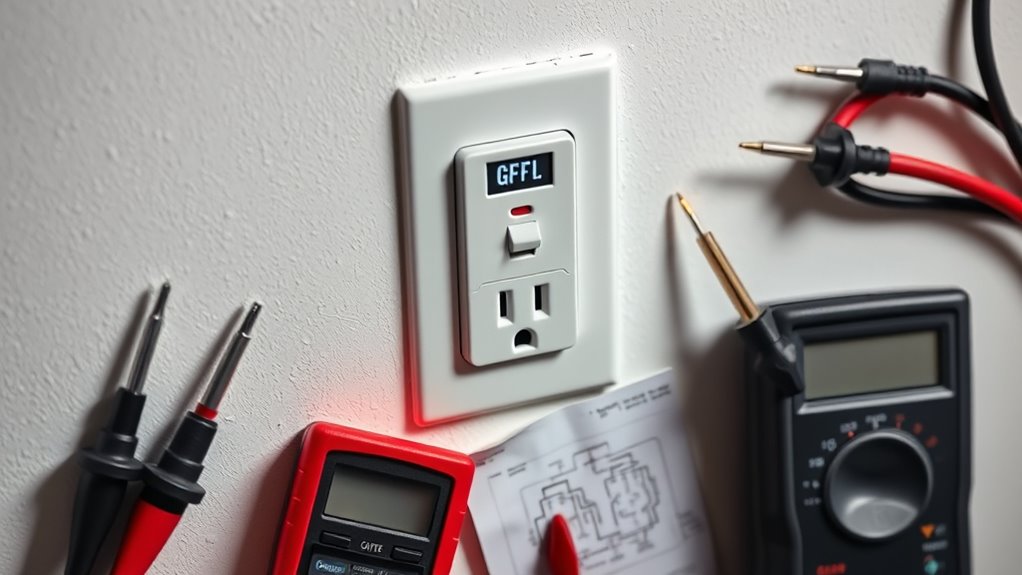
Understanding how GFCIs work is essential for recognizing why they trip and how to prevent unnecessary disruptions. GFCIs detect ground faults by monitoring the current flowing through the circuit’s hot and neutral wires. If there’s a difference, it indicates current leakage, often caused by compromised circuit insulation. When this happens, the GFCI quickly shuts off power to prevent shock hazards. Device compatibility is also crucial; installing incompatible devices can cause nuisance tripping or failure to trip when needed. Ensuring that your GFCI is compatible with your circuit’s wiring and appliances helps it function correctly. Proper installation and understanding of these basics ensure your GFCI provides reliable safety, reducing false trips and enhancing overall electrical safety in your space. Additionally, awareness of automation technologies can help in maintaining and upgrading electrical systems for better safety and efficiency.
Calculating Ground Fault Current Thresholds
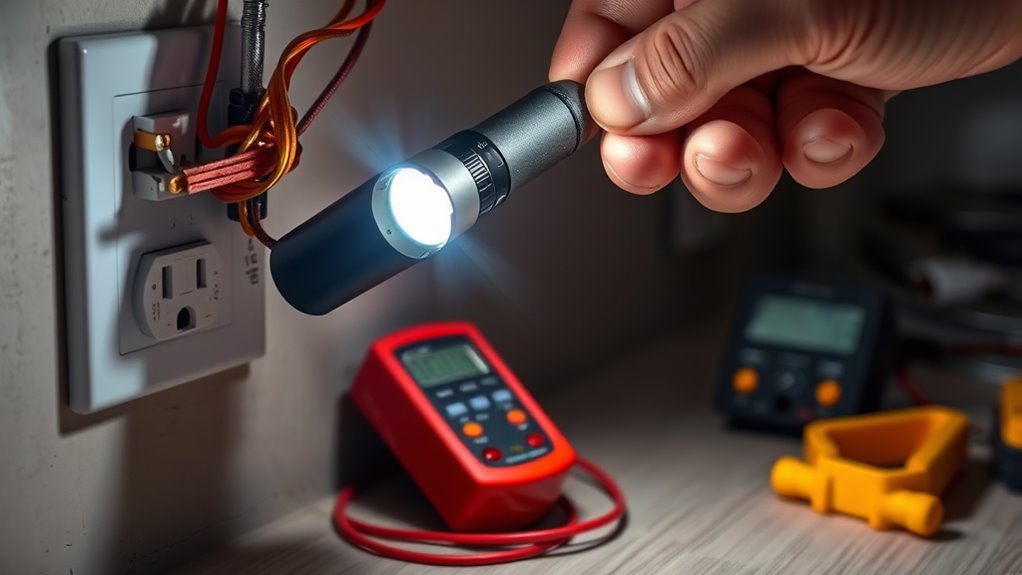
Calculating the ground fault current threshold is essential for ensuring your GFCI trips reliably without false alarms. This threshold determines the current level at which circuit protection activates, preventing electrical hazards. To set this correctly, you need to understand the typical ground fault currents that could occur in your circuit.
| Ground Fault Type | Typical Current Range |
|---|---|
| Small Leak | 5-20 mA |
| Moderate Fault | 20-50 mA |
| Severe Fault | Over 50 mA |
| Safety Limit | 6 mA (for personal protection) |
Determining Leakage Current in Circuits
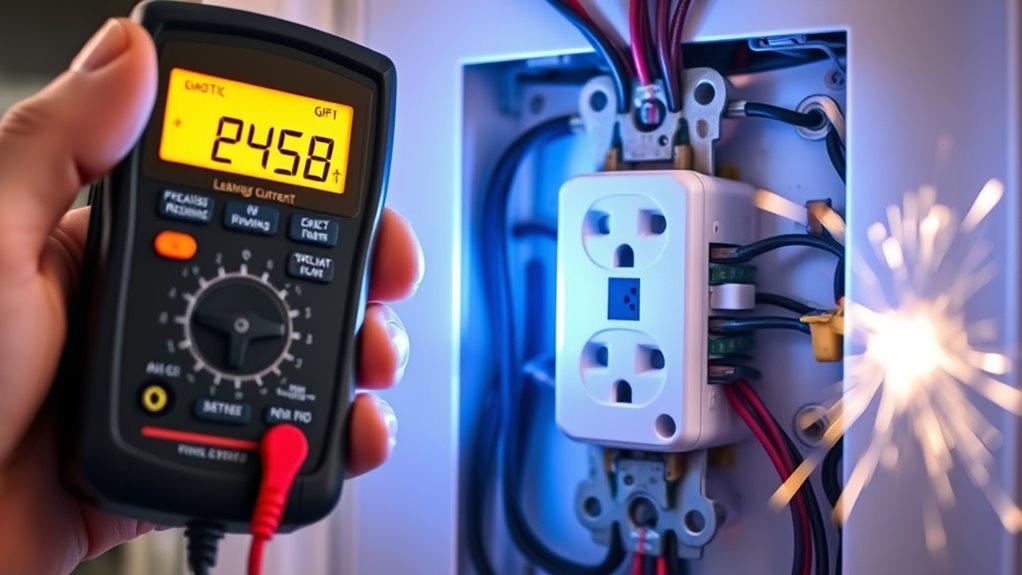
To keep your circuits safe, you need to measure leakage current accurately. Recognizing common sources of leakage helps you pinpoint issues before they cause GFCI trips. By calculating safe thresholds, you guarantee your system stays protected without unnecessary disruptions. Regularly monitoring indoor air quality is crucial, as it reflects the overall health and safety of your environment, including electrical safety considerations.
Measuring Leakage Current Accurately
Accurately measuring leakage current is crucial for diagnosing GFCI tripping issues and guaranteeing circuit safety. To get reliable leakage measurement, you should:
- Use a clamp meter designed for ground fault detection to measure leakage current directly.
- Disconnect sensitive devices to prevent false readings caused by normal operational currents.
- Ensure the GFCI is properly installed and functioning before testing.
- Record the measurement and compare it to the GFCI’s trip threshold to identify excess leakage.
- Understanding the contrast ratio of your circuit can help interpret the significance of the measured leakage levels and their impact on safety and performance.
Proper measurement helps you pinpoint if a ground fault is causing frequent trips. Remember, precise leakage measurement is indispensable to prevent safety hazards and maintain circuit integrity.
Identifying Common Sources of Leakage
Understanding the common sources of leakage current is essential for diagnosing GFCI tripping problems effectively. A ground fault occurs when current finds an unintended path to the ground, creating a leakage path. This can happen due to damaged insulation, moisture, or faulty appliances. Identifying where the leakage originates helps you pinpoint issues like worn wiring, loose connections, or compromised equipment. You might notice leakage currents around outlets, switches, or appliances connected to the circuit. Using a clamp meter or leakage tester, you can detect small amounts of current flowing through the leakage path. Properly maintaining HEPA filtration and other electrical components can help prevent insulation breakdowns that lead to leaks. Recognizing these sources allows you to address potential safety hazards and prevent unnecessary GFCI trips, ensuring the circuit’s integrity and safety.
Calculating Safe Thresholds
Determining the safe leakage current threshold is essential for preventing unnecessary GFCI trips while maintaining safety. To do this effectively, you need to understand how to calculate the maximum leakage current your circuit protection devices can handle. Here’s how you can approach it:
- Identify the GFCI’s rated trip current, usually 5 mA or 30 mA.
- Measure the leakage current in your circuit during normal operation.
- Compare the measured leakage with the GFCI’s trip threshold.
- Adjust your circuit components or wiring to keep leakage below this safe limit.
- Regularly review Gold IRA Rollovers and related investment strategies to ensure your electrical safety measures align with your overall financial security.
Analyzing the Impact of Load Size on Tripping

The size of the load connected to a GFCI outlet considerably influences its likelihood to trip. If the load exceeds the outlet’s load capacity, it can cause frequent trips, disrupting your circuit. Larger loads draw more current, which can sometimes mimic ground faults, even if no fault exists. Proper circuit design accounts for the maximum expected load, ensuring the GFCI can handle the combined demands without nuisance tripping. When designing circuits, consider how load size impacts the GFCI’s sensitivity and trip threshold. An overloaded circuit not only risks nuisance trips but can also compromise safety. By understanding your load size and ensuring it stays within safe limits, you help maintain reliable protection and prevent unnecessary interruptions. Accurate calculations and thoughtful circuit design are essential for safe, efficient operation.
Evaluating Wiring Integrity and Resistance
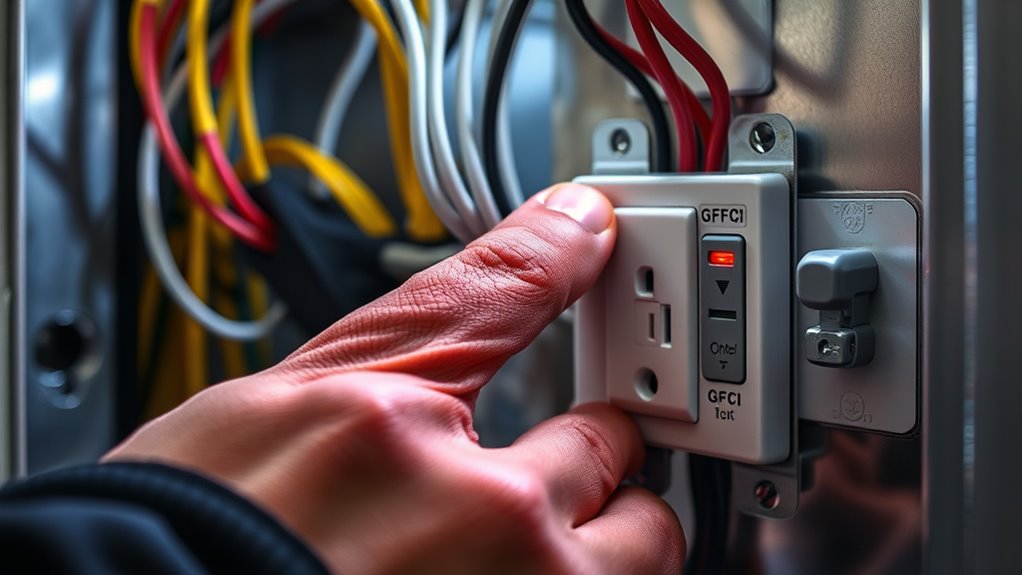
Wiring integrity and resistance directly impact the performance of a GFCI outlet. Poor wire integrity can lead to false trips or failure to trip when needed. Resistance measurement helps identify issues in the wiring system. To evaluate this, you should:
- Visually inspect wires for damage, corrosion, or loose connections.
- Use a multimeter to perform resistance measurement across circuit wires.
- Check for high resistance values indicating degraded wiring or poor connections.
- Ensure grounding and neutral wires are properly connected and intact.
Assessing the Effect of Environmental Factors
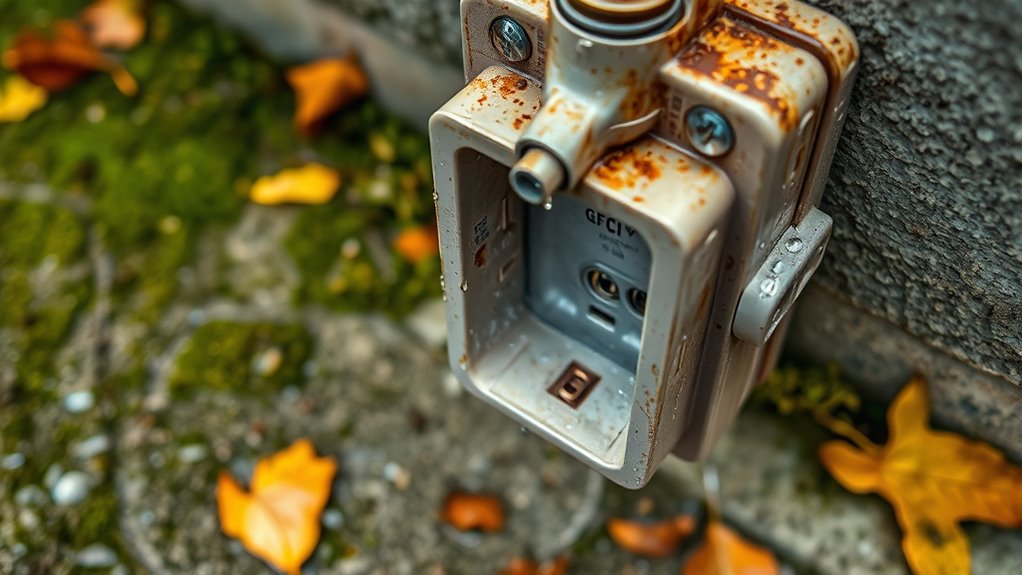
Environmental factors such as moisture, temperature fluctuations, and dust can substantially influence GFCI performance. Moisture accumulation, especially in damp or humid conditions, increases the risk of leakage currents that trip the device unnecessarily. Temperature fluctuations cause expansion and contraction of wiring and components, potentially creating micro-cracks or loose connections that affect GFCI sensitivity. Dust buildup can insulate connections or cause short circuits, leading to false trips. You need to assess these factors regularly to _guarantee_ proper operation. Keep environments dry and well-ventilated, and inspect wiring for signs of moisture or corrosion. Controlling environmental conditions minimizes false trips and maintains the safety and reliability of GFCI devices, ensuring they protect you effectively without tripping unnecessarily due to external influences. Regular maintenance and understanding electrical safety principles can further enhance GFCI effectiveness.
Interpreting GFCI Trip Time and Current Relationships
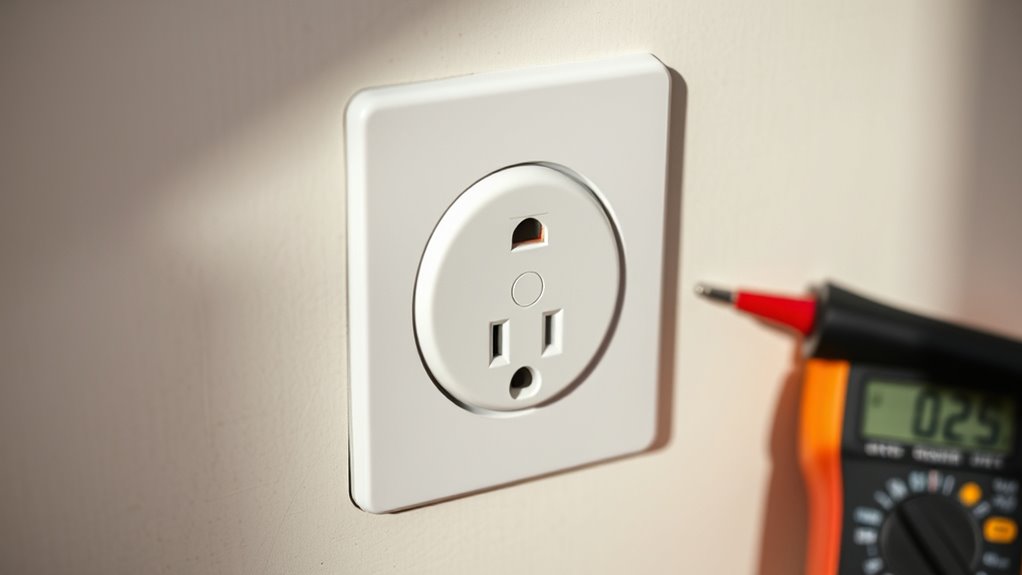
Understanding how GFCI trip time relates to the current leakage helps you interpret device responses accurately. When a ground fault occurs, the GFCI follows a trip curve that defines how quickly it responds at different leakage levels. To analyze this relationship, consider these key points:
- The trip curve shows the relationship between leakage current and trip time.
- Higher ground fault currents cause faster trips, often within milliseconds.
- Lower leakage currents may take seconds or longer to trip, indicating sensitivity levels.
- Knowing the trip curve helps you predict whether a GFCI will trip promptly or delay, aiding in troubleshooting and safety assessments.
- The trip response is also influenced by personality test factors such as the device’s design and calibration, which can affect its sensitivity and trip time.
Using Test Devices to Measure Leakage Levels
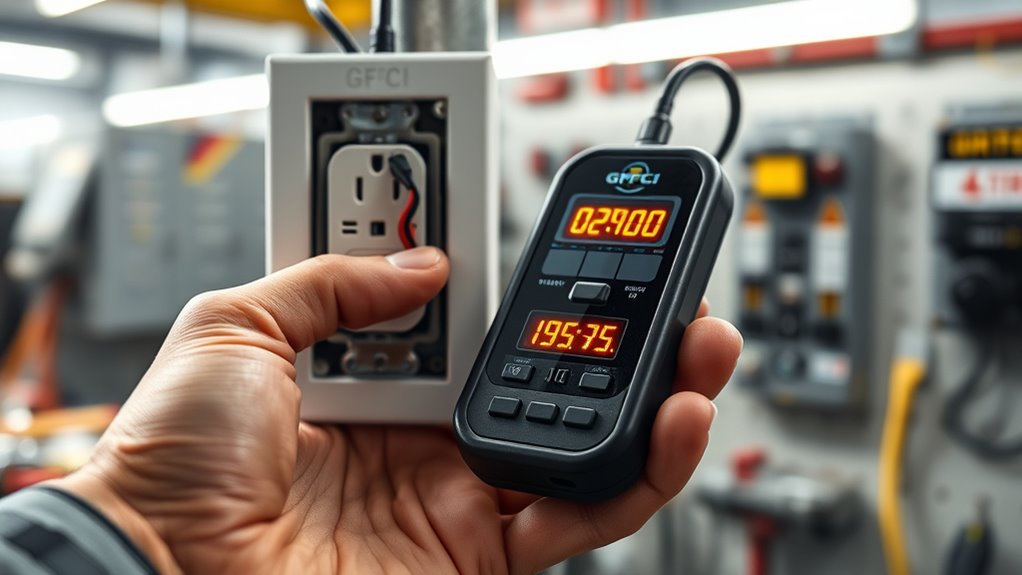
Using test devices to measure leakage levels allows you to accurately assess ground faults and guarantee safety. These devices detect tiny currents that indicate leakage, helping prevent false trips caused by power surges or faulty wiring. To guarantee reliable readings, test your GFCI regularly, especially if you notice frequent circuit breaker trips. Use a multimeter or specialized GFCI tester to measure leakage levels directly. Here’s a quick reference:
| Device Type | Typical Use | Key Feature |
|---|---|---|
| Multimeter | General testing, voltage & leakage | Precise readings |
| GFCI Tester | Quick, plug-in testing | Easy to use, visual indicators |
| Clamp Meter | Measuring leakage current | Non-contact, portable |
Additionally, regularly inspecting your GFCI for proper functioning helps maintain safety and prevents potential hazards.
Safety Margin Calculations for GFCI Settings
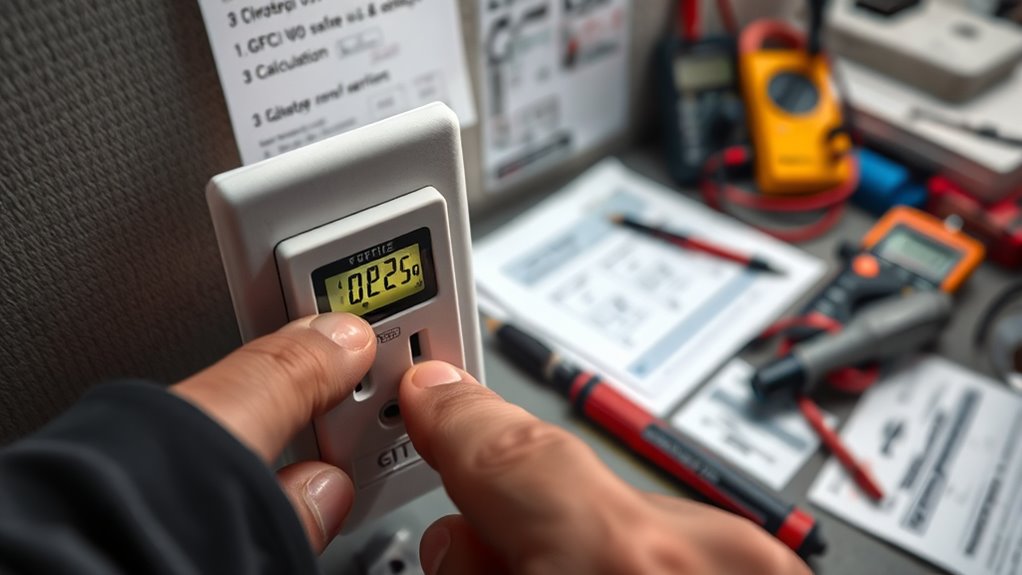
To guarantee maximum protection, you need to calculate the appropriate safety margin for your GFCI settings. This ensures reliable circuit protection against ground faults without unnecessary tripping. First, determine the maximum expected ground fault current in your system. Second, set the GFCI trip threshold slightly above this value—typically 20-30% higher—to avoid nuisance trips. Third, consider the sensitive nature of connected equipment and adjust accordingly. Fourth, regularly verify the margin by testing the GFCI with a test device. Proper safety margin calculations help prevent ground fault conditions from going unnoticed while maintaining safe circuit protection. By fine-tuning your GFCI settings, you reduce trip risks and enhance overall safety.
Troubleshooting Common Fault Conditions Using Calculations
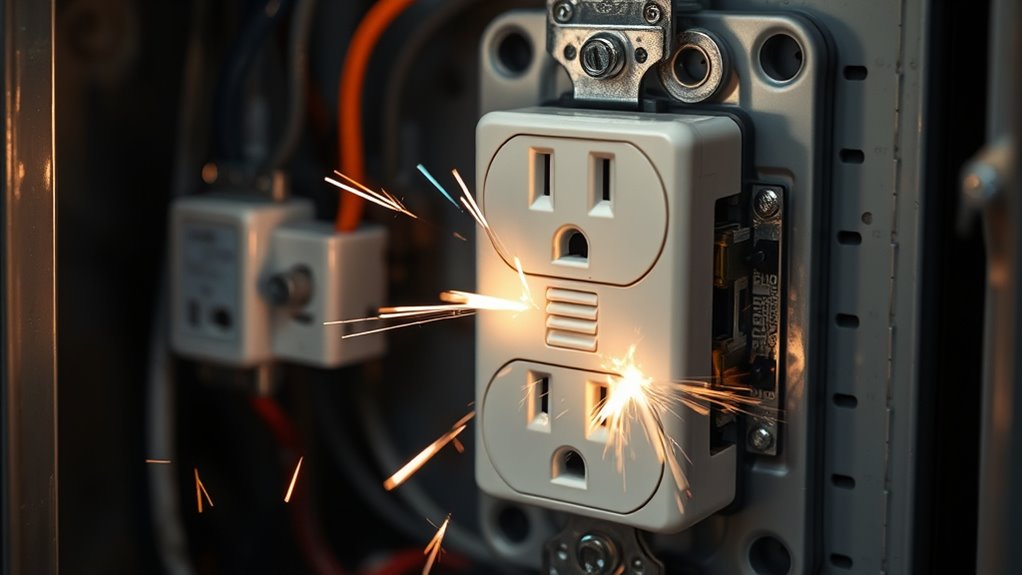
When troubleshooting GFCI tripping issues, performing precise calculations can help identify the underlying fault conditions. By analyzing ground fault currents and circuit resistance, you can pinpoint issues causing tripping. For example, if there’s a ground fault, the current leaks to ground, reducing circuit resistance. Calculating the fault current helps determine if it exceeds the GFCI’s trip threshold. Use this table to guide your troubleshooting:
| Fault Condition | Circuit Resistance | Expected Ground Fault Current |
|---|---|---|
| No fault | Normal resistance | Below trip threshold |
| Ground fault present | Reduced resistance | Exceeds trip threshold |
| Loose connection | Increased resistance | No trip or delayed trip |
These calculations empower you to identify faults quickly and ensure safety.
Frequently Asked Questions
How Often Should GFCIS Be Tested for Optimal Safety?
You should test your GFCIs at least once a month to guarantee peak safety. Regular trip testing helps you detect ground fault issues early, preventing potential electric shocks or fires. When you press the test button, it simulates a ground fault, causing the GFCI to trip if functioning correctly. Consistent testing keeps your ground fault protection reliable, so make it a monthly habit for peace of mind.
What Are Signs of a GFCI Malfunction Beyond Tripping?
Did you know that about 10% of GFCI failures are due to corrosion or wiring faults? Beyond tripping, signs of a GFCI malfunction include persistent or false trips, frequent wiring issues, or visible corrosion on the device. You should also watch for fading or damaged test and reset buttons. If you notice these signs, it’s time to examine and possibly replace your GFCI to ensure safety and proper operation.
Can Improper Grounding Affect GFCI Trip Accuracy?
Improper grounding can definitely affect GFCI trip accuracy. Grounding issues may cause false triggers, making the GFCI trip even when there’s no real fault. When your GFCI isn’t properly grounded, it can’t reliably detect leakage currents, leading to potential safety risks or nuisance trips. To prevent this, verify your system is correctly grounded, which helps maintain accurate trip functions and avoids false triggers.
How Do Environmental Conditions Influence GFCI Reliability?
Think of your GFCI like a sensitive alarm system; environmental conditions like humidity impact its reliability. High humidity can cause moisture buildup inside outlets, leading to false trips. Temperature fluctuations also affect its performance—extreme heat or cold can distort internal components, reducing accuracy. You need to contemplate these factors because, just like a warning light, your GFCI depends on stable conditions to protect you effectively.
What Is the Recommended Maintenance Schedule for GFCI Safety Checks?
You should check your GFCI outlets monthly to guarantee ground fault prevention and maintain safety compliance. Test the device by pressing the test button and reset it afterward. Annually, perform a more thorough inspection, including checking for signs of wear or damage. Regular maintenance helps prevent tripping issues, ensuring reliable protection and keeping your environment safe. Don’t skip these safety checks; they’re essential for ongoing electrical safety.
Conclusion
Understanding GFCI tripping isn’t just about numbers; it’s like tuning a finely crafted instrument. When you master these calculations, you’re tuning your safety system to respond perfectly—not too sensitive, not too lax. Think of it as balancing on a tightrope, where precision keeps you safe. With these tools, you can confidently troubleshoot and guarantee your circuits stay secure, turning potential hazards into a well-orchestrated harmony of safety.








